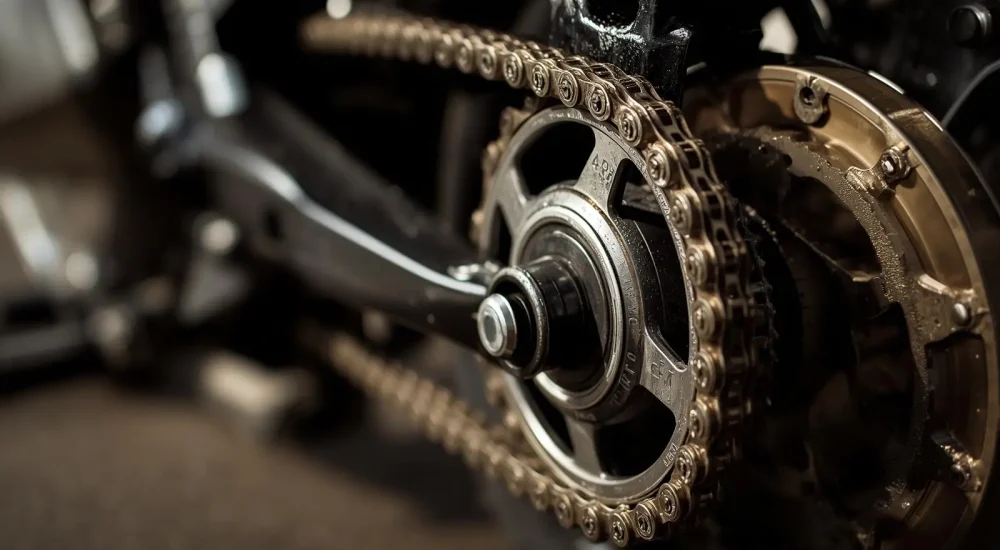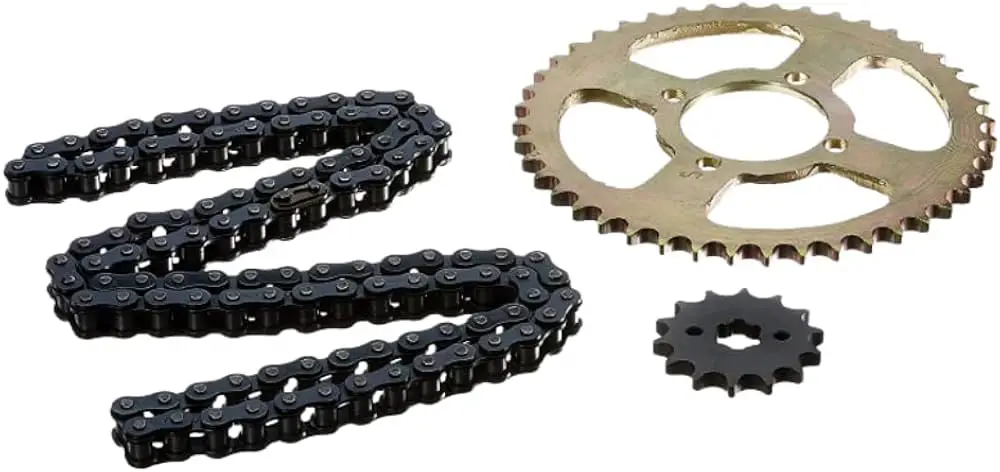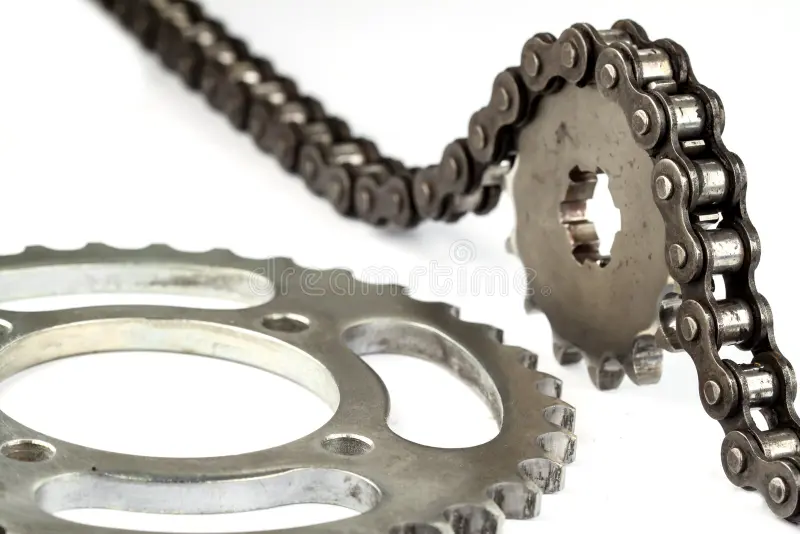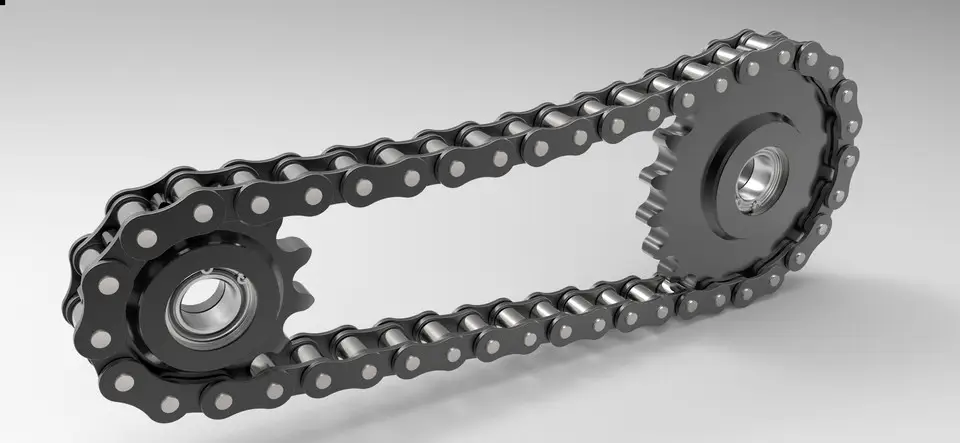Motorcycle Chains & Sprockets: The Complete Guide to Performance, Maintenance & Upgrades
If you ride a motorcycle, you know every part matters. Each piece affects how the bike feels, sounds, and performs. But some parts get ignored until there’s a problem. Motorcycle chains and sprockets are a perfect example. They connect the engine to the rear wheel. If they’re worn out, your engine can’t deliver power properly. Even the best bike won’t ride right without them. They’re small but essential.
We will help you understand chains & sprockets. You’ll learn how they affect performance. You’ll learn when to replace them. You’ll also learn how to maintain them. And how to pick upgrades that really make a difference. If you ever search for motorcycle spare parts online, you should know what to look for. It helps you avoid mistakes. A trusted motorcycle spare parts supplier, such as Bikebox makes it simple. We offer genuine parts. We give good advice, too.
By the end, you’ll feel confident. You’ll know how to check your chain. You’ll know how to clean it. You’ll know when to replace it. You’ll even know how to upgrade it. Let’s get started.
What Are Motorcycle Chains & Sprockets?
Every chain‑drive motorcycle has two sprockets. One sprocket is attached to the engine. That’s called the front sprocket. The other sprocket is fixed to the rear wheel. That’s the rear sprocket. A chain links the front and rear sprockets. When you rotate the handle to speed up, the engine turns the front sprocket. This makes the chain move. And that’s what makes your bike move forward. The rear sprocket turns. The wheel spins. That’s how your motorcycle moves.
Here are key parts:
- Chain: A loop made of links, rollers, plates, and pins. Sometimes, with special seals (O‑rings, X‑rings, Z‑rings) between links to trap lubricant and keep dirt out.
- Sprocket: A toothed wheel. Teeth engage with chain rollers or links. They come in steel or aluminum. The front sprocket is smaller; the rear is larger.
Different chain types:
- Standard (non‑sealed): No seals. Less weight, less cost. But needs lots of cleaning and lubrication. Dirt gets in. Wear happens faster.
- O‑ring chain: Seals around the links. Keeps grease in. Keeps dirt out. Lasts longer. Slightly more friction.
- X‑ring chain: More advanced seal type. Better sealing, less friction increase, and longer lifespan than simple O‑rings.
Want to know which chain type really delivers the best performance and value? Check out this ultimate comparison of O-Ring, X-Ring, and Standard chains
Get the right chain for the right performance – browse our collection of motorcycle chains & sprockets.

Different sprocket materials:
- Steel sprockets: Tough. Wear slowly. Heavier. Good for commuting, touring, and heavy loads.
- Aluminum sprockets: Lightweight. Better acceleration and responsiveness. But wear faster. Need more frequent replacement. Sometimes used in performance or racing applications.
Sprocket tooth count is important too. The ratio between front and rear sprockets affects how quickly your bike accelerates versus how fast it can go. For help deciding between steel and aluminum, see which sprocket material is right for you.
How Chains & Sprockets Affect Performance
These parts seem simple. But their condition, type, and setup change how your bike behaves. Understanding common issues can help you keep them in top shape:
1. Power Transfer
A good chain and matching sprockets transfer power with minimal loss. If the chain is worn, loose, dirty, or misaligned, energy is wasted. The bike feels less responsive.
2. Acceleration vs Top Speed
Changing sprocket sizes can shift performance leanings. More teeth on the rear sprocket = better low-end pull/acceleration; fewer teeth = higher top speed. Changing the front sprocket size also has a big effect. But changing the ratio too much can overstress the chain or reduce the engine safety margin.
3. Fuel Efficiency
If the chain drags or has high friction (due to rust, dirt, or poor lubrication), the engine works harder. That means more fuel is used for the same output. A clean, well‑lubed, properly tensioned chain helps economy.
4. Handling, Noise, Vibration & Safety
Loose chains may jump or skip. That causes noise and rough movement. Worn sprockets may cause the chain to skip. Misalignment causes uneven wear and the risk of the chain coming off. This is dangerous. Also, vibration from the drivetrain can make the bike uncomfortable or cause fatigue.
5. Longevity of Other Parts
The chain & sprockets are part of a drivetrain system. If the chain is bad, it can wear out sprockets faster. If sprockets are worn, even a new chain won’t last. So mismatches cost you more in the long run.
You can learn more in this guide to the most common motorcycle chain problems and how to fix them.
Don’t let worn parts slow you down. Upgrade with genuine chains and sprockets now.

The Signs You Need a Replacement
You want to catch wear early. It saves money and prevents problems. Here are signs to look for:
1. Excess slack or chain elongation
Slack means the chain is too loose. The chain elongates over time (pins and bushings wear). If slack gets too big, it may skip. If too tight, it stresses bearings.
2. Hooked, shark‑tooth, or sharp sprocket teeth
New sprocket teeth are flat or slightly rounded at the tip. Worn sprocket teeth can look hooked or pointed. They may wear more on one side. Spaces between teeth may flatten out.
3. Rust, stiff, or seized links
If the links are not moving smoothly, or one or more are stiff, low‑sided, that’s bad. Also, rust weakens the metal and damages seals.
4. Unusual noise or vibration
Hear rattles? Squeaks? Loud sounds? Feel vibration from the back of the bike? Your chain could be dry. It might be misaligned. Or it could be worn out.
5. Master link or sealed‑ring damage
If seals (O‑rings, X‑rings) are damaged, coming off, or the master link is loose or worn.
6. Visible wear at different spots
Chain wear is often uneven. Check the chain over its full rotation. Some sectors may show more wear or slack than others.
7. Mileage and history
Even if everything looks ok, if you have many thousands of miles/hundreds of hours, parts may be nearing the end of their life. Off‑road, wet, dusty, salt‑air use makes wear much faster.
When you notice any of these signs, plan to replace the part. It’s best to do this before it fails. Here are the top 5 signs of a worn-out sprocket you shouldn’t ignore.
Choosing the Right Chain & Sprocket Setup
Now, when you decide to replace or upgrade, you should make good choices. Don’t just pick the cheapest. Match to your use and budget.
Match chain size to your bike specs
Check your owner’s manual for chain pitch, width, and strength. Using the wrong size causes fast wear or failure.
Choose sealed vs non‑sealed
If you ride daily, in rain, dusty, or sticky conditions, sealed chains (O‑ring / X‑ring) are worth the cost. They need less frequent cleaning. If you ride clean roads only, maybe non‑sealed chains are okay.
Select appropriate sprocket material
Steel is ideal if you want long life and durability. Aluminum, if you want lighter weight and quicker response. Sometimes, you need to find a balance. Some chains have a steel core. Others have aluminum teeth. Or they use anodized aluminum. Each choice has its pros and cons.
Pick tooth count/gearing ratio
If you want better acceleration (for city riding, stopping/starting), go for a slightly larger rear sprocket or a smaller front sprocket. If highway speed or long stretches matter more, go opposite. But be careful: too far off stock changes the speedometer error, stressing the chain.
Brand and quality
Go for a known, trusted brand. Why? Higher machining accuracy, better materials, good sealing, and good matching. Quality parts cost more up front but last longer. If you need motorcycle spare parts, check out this guide to motorcycle chains and sprocket materials for performance.

How to Maintain Your Chain & Sprockets
Maintenance isn’t hard. It becomes a habit. Do this regularly to get the best lifespan and performance.
Cleaning
- Clean off dirt, grime, sand, and mud. These damages sprocket teeth and seals.
- Use a chain‑specific cleaner or degreaser. Do not use wire brushes. Use soft nylon brushes or purpose chain‑brush tools.
- After cleaning, rinse (if product allows), then dry well before lubrication.
Lubrication
- Lubricate the chain so grease gets into the rollers and pins. On sealed chains, focus on the outer side and avoid damaging seals. Use lubricants made for motorcycle chains. Avoid general oils.
- Frequency: after cleaning, after wet riding, or every few hundred miles (for non‑sealed). For sealed chains, maybe less often, but still regularly.
Tension Adjustment
- There should be a specified slack in your manual. Measure at the midpoint between sprockets.
- Avoid over‑tightening, as it causes damage. Too loose is dangerous.
Alignment
- Front and rear sprockets must be aligned in the same plane. Misalignment causes uneven wear and noise.
- Use the swingarm alignment marks (if present), or use a straightedge or alignment tools.
Inspect Regularly
- Look for rust, stiff links, and wear in sprocket teeth.
- Observe chain elongation. Inspect seals.
- Check the master link, bolts, and nuts for tightness.
After Wet / Mud / Long Ride Care
- Clean immediately after riding through wet or muddy conditions.
- Lubricate while the chain is warm. A warm chain allows the lube to penetrate better.
Record Keeping
- Keep track of when you cleaned, lubed, adjusted tension, and replaced chain/sprockets. Helps you anticipate the next maintenance.
You can know more about: Motorcycle Chain Maintenance: Cleaning, Lubricating, and Adjusting Guide.
Step‑by‑Step Chain & Sprocket Replacement Guide
Replacing them yourself is difficult, but doable with care and the correct tools. If you like working on your bike, follow this:
Tools you’ll need:
- Chain breaker or chain connector tool
- Wrenches/sockets plus torque wrench
- Screwdrivers
- Cleaning supplies (chains, sprockets)
- Chain lube
- New chain, front sprocket, rear sprocket (kit if possible)
- Stand or paddock stand (to lift the rear wheel or make removal easier)
Replacement Steps:
1. Prepare safely
Put the bike on the center stand or paddock stand. Ensure stability. Remove or loosen any parts that block access to the chain or sprockets.
2. Remove the old chain
Find the master link (if applicable) and remove it. If the chain is riveted, use a chain breaker to split it.
3. Remove the rear wheel
Often necessary to get the rear sprocket off. Loosen the axle, remove the wheel (follow your manual).
4. Remove sprockets
- Front sprocket: remove the sprocket cover, unscrew the sprocket nut or bolts.
- Rear sprocket: unscrew bolts holding sprocket to wheel.
5. Fit the new sprockets
- Clean the surfaces (hub, shaft) first.
- Place new sprockets. Fit bolts/nuts. Torque to spec (found in manual).
6. Install a new chain
Place the chain over the sprockets. Fit master link or rivet ends. If you’re using a rivet-type chain, be sure to follow the correct method. This DIY guide to installing a motorcycle chain and sprocket set learn you through the process step by step.
7. Tension & align
Adjust chain slack to specs. Adjust chain alignment. Use swingarm marks or an alignment tool.
8. Lubricate the new chain
Apply lube thoroughly. Shake or rotate the wheel so the chain moves and the lube spreads. Remove excess.
9. Test
- Spin the wheel by hand to check that the chain moves freely, with no tight spots.
- Ride gently for the first few miles. Listen for odd sounds. Recheck tension after maybe 50‑100 miles.
Performance Upgrades & Pro Tips
Want better performance? These upgrade ideas can help. Just weigh cost vs benefit.
Lightweight sprockets
Aluminum rear sprockets shave weight. Less unsprung or rotating mass helps acceleration. But remember: they wear faster.
Upgrade chain type
If you ride hard, consider moving from a sealed O‑ring to an X‑ring chain. Better seals and less friction.
Coated or colored chains
These are mostly cosmetic. But coatings often help with corrosion resistance. A chain with good plating or coating lasts longer in wet or salty environments.
Change the gearing ratio moderately
One tooth more on the rear or one less tooth on the front can make a noticeable difference. But don’t go to extremes. It may stress the chain or lower the top speed too much.
Better quality fasteners, master links, and keep spares
A good master link that properly locks matters. Loose nuts on sprockets can lead to trouble.
Choose an upgrade as a set
Always change both the front and rear sprockets when you replace a new chain. Using old sprockets with a new chain can cause the chain to wear out much faster.
Watch the riding style
Smooth throttle, moderate shifts, gentle starts & stops help chain life. Aggressive launches, increasing engine speed, and heavy loads shorten life.
Keep the chain warm when lubing
After a ride, the chain is warm. Apply lube then. Lubricant penetrates better and flows into the links more easily.
Budget Breakdown: What You’ll Spend (and Where You Can Save)
Cost depends on brand, type, and material. Here is a rough breakdown. These are estimates; your local prices may vary.
Item | Low-End / Basic | Mid-Range | High-End / Performance |
Non‑sealed standard chain | Lowest cost (used on older or basic bikes) | — | — |
Sealed chain (O‑ring) + matching sprockets (steel) | Moderate cost | Good value brands | Premium brands with coatings |
X‑ring or premium sealed chain | Higher cost | Upper mid-range | Racing‑grade, treated finishes |
Aluminum sprocket(s) | More expensive than steel | Thinner, light alloy options | Anodized, high‑end material |
Labor/tools (if you hire or buy tools) | Low if basic labor | Moderate | Higher if specialty tools are used |
Where you can save:
- Buy chain + sprocket kits. Kits often have a lower total cost than buying parts separately.
- Stick with steel sprockets unless you really need lightweight upgrades. Steel lasts a lot longer.
- Do some maintenance yourself. Cleaning, lubrication, and tension checks are easy and don’t need fancy tools.
- Buy from a reliable motorcycle spare parts supplier: quality matters, because cheap parts are not good.
- Use seasonal deals or bulk purchases. Sometimes shops discount chains in the off-season.
Upgrade your ride with durable kits – order now and enjoy lasting performance.

Keep Your Motorcycle Chains & Sprockets in Top Shape for Peak Performance
Chains & sprockets may not be the flashiest part of your motorcycle. They are not like paint jobs or exhaust. But they are vitally important. A bad chain or worn sprockets can reduce performance, ruin fuel economy, make noise, or even be dangerous.
Take time to inspect them. Maintain them well. Use good-quality parts. When you need replacement, go for parts that match your bike and riding style. If you ride off‑road or in wet conditions, sealed chains and good coatings matter more. If you ride on clean roads, maybe simpler parts will do.
If you ever need to buy motorbike spare parts online or locate a good bike spare parts shop, consider Bikebox. We stock genuine chains & sprockets, offer good warranties, have expert advice, and often show parts matching your model so you get the fit right.
Ride smooth. Ride safe. Keep your chain tight and your mounts secure. Your bike will thank you.
Frequently Ask Questions
Usually, replace them every 15,000 to 20,000 miles. Check for too much slack, rust, or worn teeth. Taking care of them regularly helps them last longer. It also keeps your bike running better.
Yes! Upgrading can make a big difference. Better chains or sprockets mean better acceleration. They also last longer and handle power well. You can pick steel or aluminum, depending on how you ride. Many racers and bike lovers go for performance upgrades.
Clean and lube your chain often. It’s a must. Check the chain tension regularly. Your bike’s manual will show the right amount. Good maintenance stops wear and rust. It also keeps your ride smooth and safe.
Trusted services like Bikebox sell real parts. We also give expert advice. Buying from a reliable motorcycle spare parts supplier means quality. It also ensures the parts fit your bike perfectly.
Listen for unusual noises like rattling or clanking. Check for uneven chain slack, visible wear on sprocket teeth, or rough movement. Ignoring these signs can lead to poor performance and possible damage.
